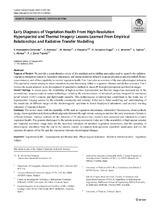Mostrar el registro sencillo del ítem
Early diagnosis of vegetation health from high-resolution hyperspectral and thermal imagery: lessons learned from empirical relationships and radiative transfer modelling
| dc.contributor.author | Hernández Clemente, Rocío | |
| dc.contributor.author | Hornero, Alberto | |
| dc.contributor.author | Möttus, Matti | |
| dc.contributor.author | Penuelas, J. | |
| dc.contributor.author | González Dugo, V. | |
| dc.contributor.author | Jiménez, J. C. | |
| dc.contributor.author | Suárez, L. | |
| dc.contributor.author | Alonso, L. | |
| dc.contributor.author | Zarco-Tejada, Pablo J. | |
| dc.date.accessioned | 2024-01-30T13:21:29Z | |
| dc.date.available | 2024-01-30T13:21:29Z | |
| dc.date.issued | 2019 | |
| dc.identifier.issn | 2198-6436 | |
| dc.identifier.uri | http://hdl.handle.net/10396/26846 | |
| dc.description.abstract | Purpose of Review We provide a comprehensive review of the empirical and modelling approaches used to quantify the radiation–vegetation interactions related to vegetation temperature, leaf optical properties linked to pigment absorption and chlorophyll fluorescence emission, and of their capability to monitor vegetation health. Part 1 provides an overview of the main physiological indicators (PIs) applied in remote sensing to detect alterations in plant functioning linked to vegetation diseases and decline processes. Part 2 reviews the recent advances in the development of quantitative methods to assess PI through hyperspectral and thermal images. Recent Findings In recent years, the availability of high-resolution hyperspectral and thermal images has increased due to the extraordinary progress made in sensor technology, including the miniaturization of advanced cameras designed for unmanned aerial vehicle (UAV) systems and lightweight aircrafts. This technological revolution has contributed to the wider use of hyperspectral imaging sensors by the scientific community and industry; it has led to better modelling and understanding of the sensitivity of different ranges of the electromagnetic spectrum to detect biophysical alterations used as early warning indicators of vegetation health. Summary The review deals with the capability of PIs such as vegetation temperature, chlorophyll fluorescence, photosynthetic energy downregulation and photosynthetic pigments detected through remote sensing to monitor the early responses of plants to different stressors. Various methods for the detection of PI alterations have recently been proposed and validated to monitor vegetation health. The greatest challenges for the remote sensing community today are (i) the availability of high spatial, spectral and temporal resolution image data; (ii) the empirical validation of radiation–vegetation interactions; (iii) the upscaling of physiological alterations from the leaf to the canopy, mainly in complex heterogeneous vegetation landscapes; and (iv) the temporal dynamics of the PIs and the interaction between physiological changes. | es_ES |
| dc.format.mimetype | application/pdf | es_ES |
| dc.language.iso | eng | es_ES |
| dc.publisher | Springer | es_ES |
| dc.rights | https://creativecommons.org/licenses/by-nc-nd/4.0/ | es_ES |
| dc.source | Current Forestry Reports 5:169–183 (2019) | es_ES |
| dc.subject | Vegetation health | es_ES |
| dc.subject | Hyperspectral and thermal data | es_ES |
| dc.subject | Physiological indicators | es_ES |
| dc.subject | Radiative transfer models | es_ES |
| dc.subject | Vegetation indices | es_ES |
| dc.title | Early diagnosis of vegetation health from high-resolution hyperspectral and thermal imagery: lessons learned from empirical relationships and radiative transfer modelling | es_ES |
| dc.type | info:eu-repo/semantics/article | es_ES |
| dc.relation.publisherversion | https://doi.org/10.1007/s40725-019-00096-1 | es_ES |
| dc.relation.projectID | Gobierno de España. QUERCUSAT | es_ES |
| dc.relation.projectID | Gobierno de España. ESPECTRAMED | es_ES |
| dc.relation.projectID | Unión Europea. ERC-2013-SyG- 610028 IMBALANCE-P. | es_ES |
| dc.rights.accessRights | info:eu-repo/semantics/openAccess | es_ES |

